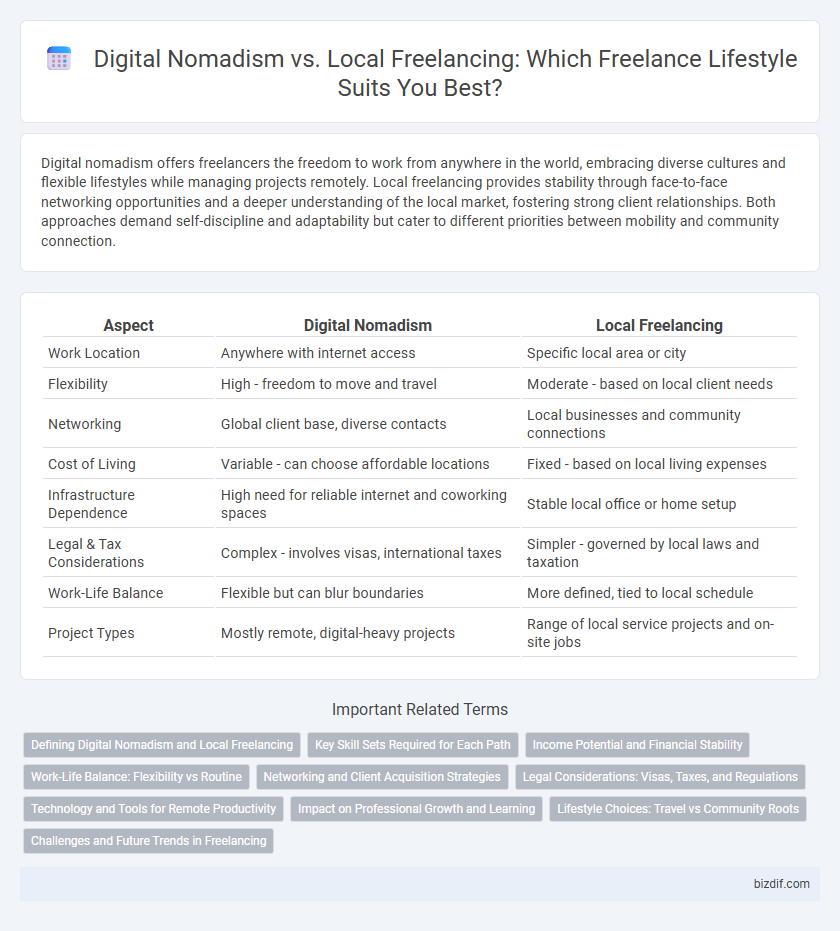Digital nomadism offers freelancers the freedom to work from anywhere in the world, embracing diverse cultures and flexible lifestyles while managing projects remotely. Local freelancing provides stability through face-to-face networking opportunities and a deeper understanding of the local market, fostering strong client relationships. Both approaches demand self-discipline and adaptability but cater to different priorities between mobility and community connection.
Table of Comparison
| Aspect | Digital Nomadism | Local Freelancing |
|---|---|---|
| Work Location | Anywhere with internet access | Specific local area or city |
| Flexibility | High - freedom to move and travel | Moderate - based on local client needs |
| Networking | Global client base, diverse contacts | Local businesses and community connections |
| Cost of Living | Variable - can choose affordable locations | Fixed - based on local living expenses |
| Infrastructure Dependence | High need for reliable internet and coworking spaces | Stable local office or home setup |
| Legal & Tax Considerations | Complex - involves visas, international taxes | Simpler - governed by local laws and taxation |
| Work-Life Balance | Flexible but can blur boundaries | More defined, tied to local schedule |
| Project Types | Mostly remote, digital-heavy projects | Range of local service projects and on-site jobs |
Defining Digital Nomadism and Local Freelancing
Digital nomadism refers to a lifestyle where freelancers leverage technology to work remotely while traveling across various locations, often embracing flexibility and cultural diversity. In contrast, local freelancing involves providing services within a fixed geographic area, fostering strong community connections and easier client interactions. Both modes rely on digital tools but differ significantly in mobility, work environment, and client engagement strategies.
Key Skill Sets Required for Each Path
Digital nomadism demands strong adaptability, self-motivation, and advanced digital communication skills to manage remote work across varying time zones and cultures. Local freelancing prioritizes deep market knowledge, personal networking abilities, and face-to-face client relationship management for sustained local business growth. Both paths benefit from expertise in project management, technical proficiency relevant to the field, and effective time-management skills tailored to their operational environments.
Income Potential and Financial Stability
Digital nomadism offers freelancers diverse income streams by tapping into global markets, often resulting in higher earning potential compared to local freelancing confined to regional demand. However, financial stability may be more challenging due to variable living costs, currency fluctuations, and inconsistent internet access. Local freelancing provides steadier income through established client relationships and predictable expenses, but income growth can be limited by the local economy's scale.
Work-Life Balance: Flexibility vs Routine
Digital nomadism offers unparalleled flexibility, allowing freelancers to choose their location and work hours, promoting a dynamic work-life balance tailored to personal preferences. In contrast, local freelancing provides a stable routine with consistent work environments, which can enhance productivity and establish clear boundaries between professional and personal life. Both approaches impact work-life balance differently, with digital nomads embracing adaptability and local freelancers benefiting from predictability.
Networking and Client Acquisition Strategies
Digital nomads leverage global networking platforms and international coworking spaces to access diverse client bases, enhancing cross-cultural communication skills and expanding project opportunities worldwide. Local freelancers typically build strong community ties through regional industry events, face-to-face meetings, and localized social media groups, fostering trust and long-term client relationships. Effective client acquisition for both models requires tailored strategies: digital nomads prioritize virtual portfolios and remote collaboration tools, while local freelancers benefit from in-person referrals and localized SEO tactics.
Legal Considerations: Visas, Taxes, and Regulations
Digital nomads must navigate complex visa requirements, often relying on specialized remote work visas or tourist permits that vary by country, while local freelancers typically comply with domestic business licenses and tax codes. Tax obligations differ significantly; digital nomads may face challenges in determining tax residency and filing taxes in multiple jurisdictions, whereas local freelancers primarily report income according to national tax authorities. Regulatory compliance for digital nomads includes understanding foreign labor laws and data protection policies, in contrast to local freelancers who adhere to established local employment regulations and licensing standards.
Technology and Tools for Remote Productivity
Digital nomadism relies heavily on cloud-based tools like Slack, Trello, and Zoom to maintain seamless communication and project management across time zones. Local freelancing often leverages similar platforms but supplements with in-person client meetings and localized network resources for enhanced collaboration. Advanced productivity apps such as Notion and Asana play crucial roles in both settings, optimizing task organization and deadline tracking regardless of physical location.
Impact on Professional Growth and Learning
Digital nomadism accelerates professional growth by exposing freelancers to diverse cultures, global markets, and varied client needs, fostering adaptability and cross-cultural communication skills. Local freelancing emphasizes deep-rooted industry networks and consistent client relationships, enabling specialization and sector-specific expertise development. Both approaches offer unique learning opportunities: digital nomads gain broad, versatile experiences, while local freelancers benefit from focused knowledge and steady career progression.
Lifestyle Choices: Travel vs Community Roots
Digital nomadism offers freelancers the freedom to work from diverse global locations, embracing a lifestyle driven by exploration and cultural experiences. Local freelancing emphasizes building deep community connections, fostering stable professional networks, and enjoying consistent environments that support long-term personal and business growth. Both lifestyle choices reflect distinct priorities: nomadic flexibility contrasts with the value placed on community roots and local engagement.
Challenges and Future Trends in Freelancing
Digital nomadism faces challenges such as unstable internet connectivity, time zone differences, and visa restrictions, impacting consistent client communication and project deadlines. Local freelancing often benefits from stronger community networks and easier access to resources but contends with limited market reach and localized economic fluctuations. Emerging trends highlight hybrid work models, increased use of AI-powered platforms for client management, and growing emphasis on digital nomad visas to support remote work globally.
Digital nomadism vs Local freelancing Infographic

 bizdif.com
bizdif.com